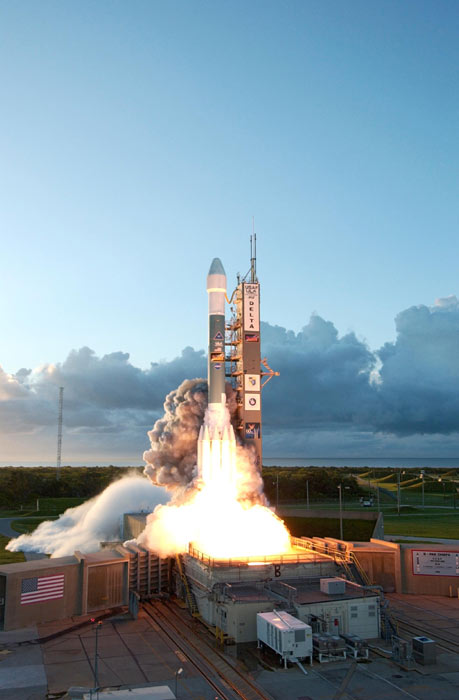Asteroid Probe's Launch Ends Long Wait for Scientists

NASA's Dawnspacecraft is in fine health after rocketing into space just after sunrise today,ending a long wait for mission scientists even as the probe's own eight-yearjourney to two large asteroids is just beginning.
For Dawnprincipal investigator Chris Russell, the liftoff capped a 15-year effort to plunderthe secretsof planetary formation from asteroids Vesta and Ceres. Russell and hismission team watchedDawn rise over its Cape Canaveral Air Force Station in Cape Canaveral, Floridafrom the spacecraft's Launch Control Center.
"Theywere very taken by today's launch," said Russell, of the University ofCalifornia, Los Angeles, of his colleagues in launch control after liftoff."In fact, my wife cried when she saw it."
NASA firstapproved Dawn'smission as part of its Discovery program for smaller, more affordable scienceexpeditions in 2001. Russell added that he first envisioned the mission usingits efficient ion drive in 1992.
Since then,the mission has survived solar array dings, weather delays, rocket booster andlaunch tracking issues, as well as cancellation in March 2006. The space agencyset the mission's current cost at about $357.5 million, not counting the costof Dawn's Delta 2 rocket.
Dawn is nowheaded for a February 2009 swing past Mars before reaching its first space rocktarget, the bright and rocky asteroid Vesta, in August 2011. The probe's novel Xenonion propulsion system is expected to guide it into orbit around Vesta foralmost a year, then send it off toward the icy dwarf planet Ceres -- thelargest space rock in the asteroid belt -- for a February 2015 rendezvous.
"Thespacecraft is safe, it is healthy and there's not a single [major] issueaboard," said Keyur Patel, Dawn project manager at NASA's Jet PropulsionLaboratory in Pasadena, Calif., after the successful launch.
Get the Space.com Newsletter
Breaking space news, the latest updates on rocket launches, skywatching events and more!
He creditedDawn's experienced mission team with tackling the last-minute hurdle of awayward ship that encroached within the launch range perimeter. The snag delayedthe probe's liftoff by about 14 minutes, after which the ship moved clear ofthe launch range in time for a 7:34 a.m. EDT (1134 GMT) space shot.
Dawn's twoexpansive solar arrays, which measure about 65 feet (about 20 meters) from tipto tip, successfully unfurled after liftoff and its primary science instrumentswere found to be in good health, mission managers said. A few minor issues,such as a one amp difference in the current produced by the two solar arrays,have popped up, but none are considered serious enough to pose a problem, theyadded.
"They'reall just fine tuning," Patel said.
By Fridaymorning, Dawn is expected to have flown beyond the orbit of the moon as it continuesits outbound flight to the asteroid belt that sits between the orbits of Marsand Jupiter.
Missionmanagers plan to test its three ion engines within about five days. A series ofinstrument checks of Dawn's optical camera, mapping spectrometer and gamma rayand neutron detector will also be performed, though the tools won't be fullycalibrated until after the Mars flyby, Patel said.
"Everytime we launch a spacecraft, they all have their own personalities," Patelsaid. "And what we're about to discover is what kind of personality Dawnhas; whether it's going to be a well-behaved child, or someone that's slightlynaughty."
- VIDEO: Dawn's Mission to Asteroids Vesta and Ceres
- GALLERY: Asteroids
- Asteroid Mission to Probe Secrets of Planet Formation
Join our Space Forums to keep talking space on the latest missions, night sky and more! And if you have a news tip, correction or comment, let us know at: community@space.com.

Tariq is the Editor-in-Chief of Space.com and joined the team in 2001, first as an intern and staff writer, and later as an editor. He covers human spaceflight, exploration and space science, as well as skywatching and entertainment. He became Space.com's Managing Editor in 2009 and Editor-in-Chief in 2019. Before joining Space.com, Tariq was a staff reporter for The Los Angeles Times covering education and city beats in La Habra, Fullerton and Huntington Beach. In October 2022, Tariq received the Harry Kolcum Award for excellence in space reporting from the National Space Club Florida Committee. He is also an Eagle Scout (yes, he has the Space Exploration merit badge) and went to Space Camp four times as a kid and a fifth time as an adult. He has journalism degrees from the University of Southern California and New York University. You can find Tariq at Space.com and as the co-host to the This Week In Space podcast with space historian Rod Pyle on the TWiT network. To see his latest project, you can follow Tariq on Twitter @tariqjmalik.










